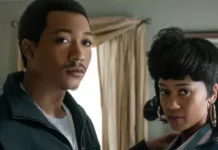
(Los Angeles, CA | March 14, 2018) Academy Award-nominee, Angela Bassett will join Kathleen Battle as a guest narrator in Battle’s program Underground Railroad: A Spiritual Journey accompanied by pianist Joel Martin and the LA-based choir, The Albert McNeil Jubilee Singers at the Younes and Soraya Nazarian Center for the Performing Arts (The Soraya) on Thursday, March 29 at 8:00pm.
Angela Bassett’s talent and abilities as an actress, director, and executive producer in both television and film have garnered well-deserved respect and acclaim from peers and fans; proving her to be one of the industry’s premier leading ladies. She currently stars in Marvel’s mega-hit movie Black Panther and Fox Television’s highly acclaimed new drama 9-1-1.
American soprano Kathleen Battle’s luminous voice has been called by The Washington Post “…without qualification, one of the very few most beautiful in the world.” Yet beyond the glory of her singing, in a career filled with countless accolades, honors and major milestones, what has perhaps distinguished her most is her almost magical ability to create an unwavering emotional bond between herself, her music and her audience. This performance will mark Ms. Battle’s debut at The Soraya.
“Kathleen Battle is an American treasure and we are delighted to present the Los Angeles premiere of her extraordinary piece honoring the legacy of the Underground Railroad,” said Thor Steingraber, The Soraya’s Executive Director. “The plight of people escaping slavery in this country is an indelible part of our history. This chapter of human migration—the journey of determined individuals seeking new opportunity or the plight of those tragically displaced—is as relevant a matter today as any time in history. The addition of Angela Bassett will connect another powerful female voice to this momentous performance.”
Kathleen Battle’s program Underground Railroad: A Spiritual Journey completes a series of five thematic attractions for the 2017-2018 season programmed by Steingraber to explore the broad movements of peoples either through immigration or migration – including Leilah Broukhim tracing her Sephardic Jewish Roots, Step Afrika! inspired by Jacob Lawrence Migration Series paintings, Dublin Irish Dance telling the story of the Irish immigration to America, and Cruzar la Cara de la Luna from Mariachi Vargas de Techlitian about Mexican-American immigration.

About Kathleen Battle: Underground Railroad – A Spiritual Journey
Kathleen Battle: Underground Railroad—A Spiritual Journey is a program of music inspired by the journey to freedom along the Underground Railroad, the 19th-century network of safe houses that allowed African-Americans to escape from slavery. Ms. Battle said. “Spirituals have the power to uplift and to heal, and we certainly need that in today’s world. This is a program, which brings together my musical background and my cultural heritage.
The concert program will feature numerous well-known Spirituals, gospel and traditional pieces, including “Lord, How Come Me Here?,” “Go Down, Moses,” “Wade in the Water,” “Roll, Jordan, Roll,” “City Called Heaven,” “Swing Low, Sweet Chariot,” “I Don’t Feel No-Ways Tired,” “Fix Me, Jesus,” “Balm in Gilead,” “Ain’t Gonna Let Nobody Turn You Me Roun’,” “Let Us Break Bread Together,” and “He’s Got the Whole World in His Hand.”
In writing about Ms. Battle’s performance at the Metropolitan Opera in 2016, The New York Times’Anthony Tommasini said, “Ms. Battle sang with remarkable freshness and beauty…she sent high phrases soaring and sang with ethereal elegance. These spirituals clearly touch her deeply. The focus of the program was the Underground Railroad, the secret network of ‘conductors’ and ‘pilots’ who, at enormous risk, helped thousands of slaves in the South find safe havens and nighttime routes to freedom in the North. The final standing ovation was tumultuous.”
In the program notes, Janet E. Bedell writes, “the Underground Railroad was a secret organization. To this day, no one knows exactly how it was organized and how many people worked for it. This was intentional, for using this road to freedom was highly dangerous for both slaves and the people who assisted them. The Fugitive Slave Law of 1793 made it a crime for slaves to leave their masters, and a yet tougher revision of the law passed in 1850 required that courts and police return escaped slaves—even if they had been free for years—to their owners. Since escaping to the North therefore no longer remained a safe option, ex-slaves were only fully protected if they continued to Canada. Slave catchers operated throughout the country, often accompanied by specially trained bloodhounds; they were ruthless and well paid for their work. Those who were caught aiding the fugitives could be financially ruined and, if they were African Americans, sold into slavery themselves.
It is estimated that more than 3,000 individuals were active in helping the fugitives, among them such remarkable African-American leaders as Frederick Douglass and Harriet Tubman, both born into slavery in Dorchester County, Maryland.
A few lucky fugitives were placed by sympathetic transport officials and captains on stagecoaches or ships, but most made the arduous journey entirely on foot. Usually moving at night, they were taught to follow the North Star to keep traveling in the right direction; thus, Frederick Douglass named his pioneering African-American newspaper The North Star.
Many spirituals contained coded language that alerted slaves to leave the plantation, to find their way to a safe station, and to watch out for slave catchers in the neighborhood.
In her book “The Music of Black Americans,” Eileen Southern eloquently sums up the role of music in the lives of African-American slaves: “Music was a primary form of communication for the slaves, just as it had been for their African forebears. Through the medium of song, the slave could comment on his problems and savor the few pleasures allowed him; he could voice his despair and his hopes, and assert his humanity in an environment that constantly denied his humanness. As in the African tradition, the songs of the slaves could tell his history and reveal his everyday concerns.” Today, the religiously inspired songs of the slaves are known as “spirituals.”
As African-American solo vocalists such as Marian Anderson and Roland Hayes finally made their way into concert halls in the early 1900s, they usually ended their programs with a group of spirituals. Often these used concert arrangements created by Harry T. Burleigh, also known as the man who inspired the slow movement of Dvořák’s “New World” Symphony, with its plaintive melody in spiritual style. These haunting songs have endured, both as treasures of American music and as an important piece of the country’s history.
Tickets for Kathleen Battle: Underground Railroad—A Spiritual Journey priced from $43-$103, are now available at ValleyPerformingArtsCenter.org or by calling (818) 677-3000. The Younes and Soraya Nazarian Center for the Performing Arts (The Soraya) is located on the campus of California State University, Northridge (CSUN), 18111 Nordhoff Street Northridge, CA 91330-8448, at the corner of Nordhoff and Lindley.
We Publish News 24/7. Don’t Miss A Story. Click HERE to SUBSCRIBE to Our Newsletter Now!





